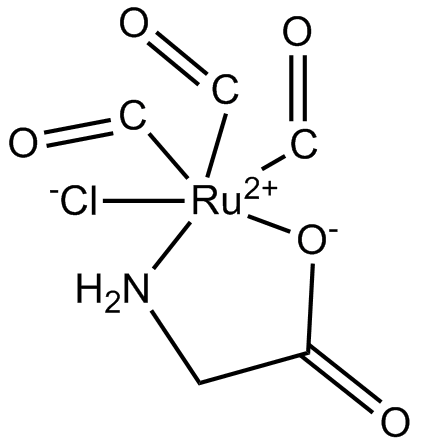CORM-3 |
| Catalog No.GC18071 |
CORM-3 is a water soluble CO-releasing molecule, uncouples mitochondrial respiration via interaction with the phosphate carrier.
Products are for research use only. Not for human use. We do not sell to patients.

Cas No.: 475473-26-8
Sample solution is provided at 25 µL, 10mM.
CORM-3 is a water soluble CO-releasing molecule, uncouples mitochondrial respiration via interaction with the phosphate carrier. It can reduce the nuclear heterotopic of NF-κB p65, reduce the production of ROS, and increase the levels of glutathione and superoxide dismutase in cells. Besides, CORM-3 reduces the activation of NLRP3 inflammasome [1-3].
CORM-3(0-400 μM; 2 hours) inhibited the effect of H2O2 on the viability of BMSCs in a dose-dependent manner. CORM-3 could reduce reactive oxygen species (ROS) accumulation and prevent mitochondrial dysfunction thereby restoring the osteogenic potential of the BMSCs disrupted by hydrogen peroxide (H2O2) exposure[4]. CORM-3(20 μM ;30 min) induces DNA damage through Ru(II) binding to DNA[5].
CORM-3(4 mg/kg; i.v) mitigated HSR-induced intestinal damages[6]. CORM-3 could effectively improve the inflammatory response induced by activation of the microglia (MG), reduce neuronal apoptosis, promote neural regeneration, and improve the learning and memory performance of mice after radiation[7].
References:
[1]. Long R, Salouage I, Berdeaux A, et,al. CORM-3, a water soluble CO-releasing molecule, uncouples mitochondrial respiration via interaction with the phosphate carrier. Biochim Biophys Acta. 2014 Jan;1837(1):201-9. doi: 10.1016/j.bbabio.2013.10.002. Epub 2013 Oct 23. PMID: 24161358.
[2]. Huang Y, Ma T, et,al. Carbon monoxide (CO) inhibits hydrogen peroxide (H2O2)-induced oxidative stress and the activation of NF-κB signaling in lens epithelial cells. Exp Eye Res. 2018 Jan;166:29-39. doi: 10.1016/j.exer.2017.08.016. Epub 2017 Oct 16. PMID: 29051011.
[3]. Lee DW, Shin HY, et,al. Carbon monoxide regulates glycolysis-dependent NLRP3 inflammasome activation in macrophages. Biochem Biophys Res Commun. 2017 Nov 18;493(2):957-963. doi: 10.1016/j.bbrc.2017.09.111. Epub 2017 Sep 21. PMID: 28942141.
[4]. Jin C, Lin BH, et,al. CORM-3 Attenuates Oxidative Stress-Induced Bone Loss via the Nrf2/HO-1 Pathway. Oxid Med Cell Longev. 2022 Aug 17;2022:5098358. doi: 10.1155/2022/5098358. PMID: 36035220; PMCID: PMC9402314.
[5]. Lyon RF, Southam HM, et,al. CORM-3 induces DNA damage through Ru(II) binding to DNA. Biochem J. 2022 Jul 15;479(13):1429-1439. doi: 10.1042/BCJ20220254. PMID: 35726678; PMCID: PMC9342897.
[6]. Zhang LM, Xin Y, et,al. CORM-3 alleviates the intestinal injury in a rodent model of hemorrhage shock and resuscitation: roles of GFAP-positive glia. J Mol Histol. 2023 Aug;54(4):271-282. doi: 10.1007/s10735-023-10133-w. Epub 2023 Jun 19. PMID: 37335421.
[7]. Lu K, Wu WJ, et,al. CORM-3 Regulates Microglia Activity, Prevents Neuronal Injury, and Improves Memory Function During Radiation-induced Brain Injury. Curr Neurovasc Res. 2020;17(4):464-470. doi: 10.2174/1567202617999200730213259. PMID: 32748746.
Average Rating: 5 (Based on Reviews and 40 reference(s) in Google Scholar.)
GLPBIO products are for RESEARCH USE ONLY. Please make sure your review or question is research based.
Required fields are marked with *




















